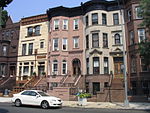87 MacDonough Street
The house located on 87 MacDonough Street in Bedford–Stuyvesant, Brooklyn has been a part of the Bedford-Stuyvesant/Stuyvesant Heights Historic District since 1975. It is one of the oldest surviving structures in the neighborhood dating back to its construction in 1863. It is owned by the United Order of Tents. The house lies in one of the nation's largest African American and Caribbean-American neighborhoods, making it distinct from other areas of the city. The Historic Districts Council describes this neighborhoods historical significance, "Although the district was constructed by dozens of architects, builders, and developers working in the late 19th century and early 20th centuries, it owes its continuing beauty to the dedication of countless homeowners who, for the past century, have safeguarded Bedford's architectural heritage, guaranteeing its survival for future generations."
Excerpt from the Wikipedia article 87 MacDonough Street (License: CC BY-SA 3.0, Authors).87 MacDonough Street
Macon Street, New York Brooklyn
Geographical coordinates (GPS) Address Nearby Places Show on map
Geographical coordinates (GPS)
| Latitude | Longitude |
|---|---|
| N 40.681388888889 ° | E -73.942777777778 ° |
Address
Macon Street 200
11216 New York, Brooklyn
New York, United States
Open on Google Maps




